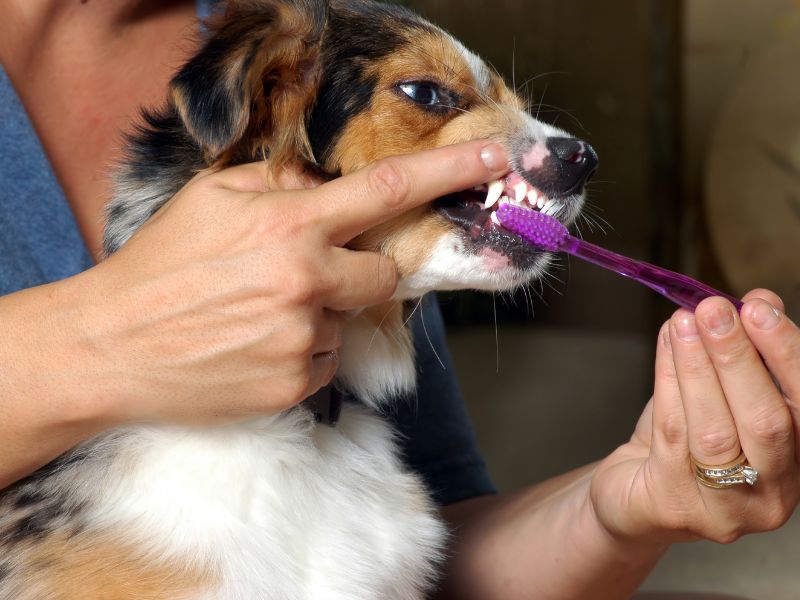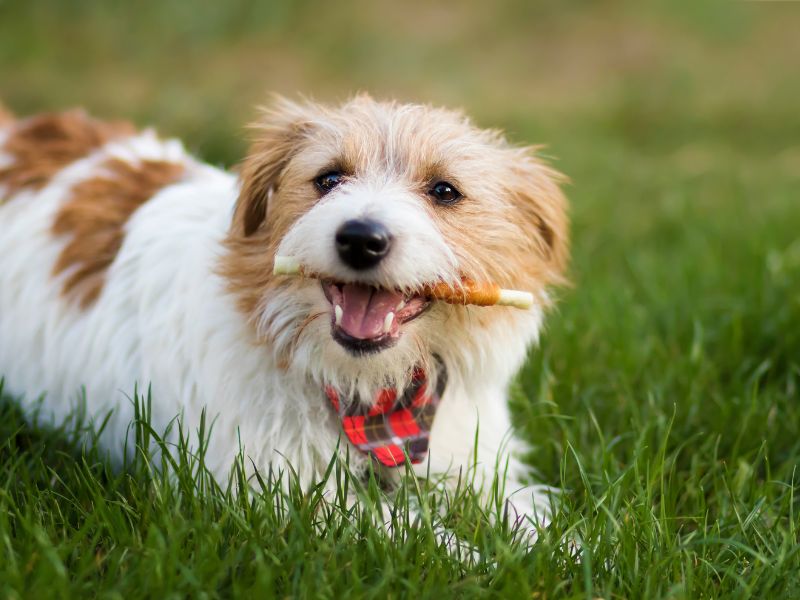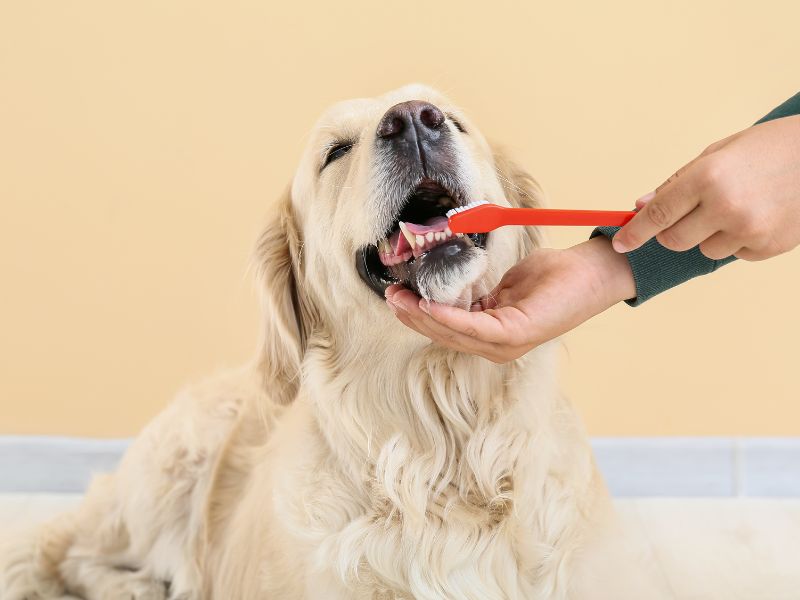Are you a proud pet parent looking to ensure your furry friend’s dental health? Look no further! In this guide, we will delve into the importance of brushing your dog’s teeth and provide you with a step-by-step tutorial on how to do it effectively. Just like humans, dogs can also suffer from dental issues such as plaque buildup, tartar, and gum disease. By establishing a regular dental care routine, you can help prevent these issues and keep your pup’s smile healthy and bright. Not only does proper dental care improve your dog’s overall health, but it also prevents bad breath and discomfort. So, grab your toothbrush and let’s dive into the world of doggie dental care. With our expert tips and advice, you’ll become a pro at brushing your dog’s teeth in no time!
The Importance of Dental Hygiene for Dogs
When it comes to our pets’ health, dental hygiene is often overlooked. However, maintaining good oral health is just as important for our furry friends as it is for us. Dogs can develop various dental problems if their teeth are not properly cared for. Plaque, tartar, and gum disease are just a few of the issues that can arise. If left untreated, these problems can lead to more serious health issues, such as infections and tooth loss.
Regular brushing is a crucial part of maintaining your dog’s dental hygiene. Brushing helps remove plaque and tartar buildup, preventing the development of gum disease and other oral infections. It also helps keep your dog’s breath fresh and their teeth clean and shiny. By incorporating regular brushing into your dog’s routine, you can ensure their overall health and well-being.
Common Dental Problems in Dogs
Just like humans, dogs are prone to dental issues. Some of the most common problems include plaque buildup, tartar, gum disease, and tooth decay. Plaque is a sticky film that forms on the teeth as a result of bacteria. Over time, if not removed, plaque hardens and turns into tartar, which can only be removed by a professional dental cleaning.
Gum disease, also known as periodontal disease, is another common issue in dogs. It occurs when bacteria in the mouth infect the gums, causing inflammation and potential tooth loss. If left untreated, gum disease can lead to more serious health problems, such as heart disease and kidney damage.
Tooth decay is also a concern for dogs, especially if they consume sugary treats or have a poor diet. Cavities can cause pain and discomfort for your furry friend, making it difficult for them to eat and enjoy their favorite activities.
Benefits Of Brushing Your Dog’s Teeth
Brushing your dog’s teeth on a regular basis offers numerous benefits. Firstly, it helps prevent the buildup of plaque and tartar, reducing the risk of gum disease and tooth decay. By keeping your dog’s teeth clean, you can also prevent bad breath, which can be a major turn-off for both you and your furry friend.
Regular brushing also allows you to monitor your dog’s oral health and catch any potential issues early on. By examining your dog’s teeth and gums regularly, you can spot signs of inflammation, swelling, or other abnormalities that may require veterinary attention. Early detection and treatment of dental problems can save your dog from unnecessary pain and discomfort.
Additionally, investing time in brushing your dog’s teeth can save you money in the long run. Regular dental cleanings at the vet can be costly, but by maintaining good oral hygiene at home, you can reduce the frequency of professional cleanings and potentially avoid more serious dental procedures.

How Often Should You Brush Your Dog’s Teeth?
The frequency of brushing your dog’s teeth depends on several factors, including their breed, age, and overall oral health. As a general rule of thumb, it is recommended to brush your dog’s teeth at least 2-3 times a week. However, some dogs may require more frequent brushing, especially if they are prone to dental issues.
Puppies should be introduced to tooth brushing early on to get them accustomed to the process. Start by gently touching their gums and teeth with your finger or a soft toothbrush. Gradually introduce toothpaste and increase the duration of brushing as your puppy becomes more comfortable.
It’s important to note that some dog breeds are more susceptible to dental problems than others. Small dog breeds, such as Chihuahuas and Yorkshire Terriers, are more prone to dental issues due to their small mouths and crowded teeth. These breeds may require more frequent brushing to maintain good oral health.
Steps To Brush Your Dog’s Teeth
Brushing your dog’s teeth may seem like a daunting task, but with a little patience and practice, it can become a seamless part of your routine. Here is a step-by-step guide to help you brush your dog’s teeth effectively:
- Start by gathering the necessary supplies: a dog toothbrush, dog toothpaste, and treats for rewards.
- Choose a quiet and comfortable area where you can easily access your dog’s mouth.
- Introduce your dog to the toothbrush and toothpaste by allowing them to sniff and taste them.
- Gently lift your dog’s lips and begin brushing their teeth using circular motions. Focus on the outer surfaces of the teeth, as that’s where plaque and tartar tend to accumulate.
- Be patient and gentle, especially if your dog is new to tooth brushing. Take breaks if needed and reward your dog with treats and praise.
- Gradually increase the duration of brushing as your dog becomes more comfortable with the process.
- Finish the brushing session with a treat or reward to create a positive association with tooth brushing.
Remember, consistency is key when it comes to brushing your dog’s teeth. The more you practice, the easier it will become for both you and your furry friend.
Choosing The Right Toothbrush and Toothpaste for Your Dog
When it comes to selecting a toothbrush for your dog, opt for one specifically designed for canine dental care. Dog toothbrushes typically have softer bristles and a longer handle, making it easier to reach all areas of your dog’s mouth. Avoid using human toothbrushes, as they may be too harsh for your dog’s teeth and gums.
Similarly, choose a toothpaste formulated for dogs. Human toothpaste contains ingredients that can be harmful if ingested by your dog. Dog toothpaste comes in a variety of flavors, such as chicken or beef, which can make the brushing experience more enjoyable for your furry friend.
Tips For Making Teeth Brushing a Positive Experience for Your Dog
Not all dogs are initially receptive to tooth brushing. However, with a few simple tips, you can make the experience more enjoyable for your furry friend:
- Start slow: Introduce tooth brushing gradually by allowing your dog to sniff and taste the toothpaste. Gradually work your way up to brushing their teeth.
- Make it a positive experience: Use treats, praise, and rewards to create a positive association with tooth brushing. This will help your dog associate the activity with something enjoyable.
- Be patient and gentle: Take your time and be gentle when brushing your dog’s teeth, especially in the beginning. Remember, it’s a learning experience for both of you.
- Use the right tools: Invest in a toothbrush and toothpaste specifically designed for dogs. This will make the process easier and more effective.
- Stay consistent: Establish a regular dental care routine and stick to it. Consistency is key when it comes to maintaining good oral health for your dog.

See Also: The Best Dog Names and How to Pick One
And: How to Take Better Photos of Your Dog
Alternative Dental Care Options for Dogs
While brushing is the most effective way to maintain your dog’s oral health, there are alternative options available for those who struggle with tooth brushing. Here are a few alternative dental care options for dogs:
- Dental chews and treats: There are a variety of dental chews and treats available that can help reduce plaque and tartar buildup. Look for products approved by veterinary associations, as they are formulated to promote dental health.
- Dental rinses and sprays: Dental rinses and sprays can help freshen your dog’s breath and reduce bacteria in their mouth. These products are easy to use and can be a good addition to your dog’s oral care routine.
- Water additives: Some water additives are designed to promote dental health by reducing plaque and tartar buildup. Simply add the recommended amount to your dog’s water bowl, and they will benefit from improved oral hygiene.
While these alternative options can be helpful, they should not replace regular tooth brushing. Consult with your veterinarian to determine the best combination of dental care practices for your dog.
Signs Of Dental Problems in Dogs
It’s important to be vigilant and watch out for signs of dental problems in your dog. Some common signs include:
- Bad breath: Persistent bad breath is often a sign of dental issues such as gum disease or tooth decay.
- Difficulty eating: If your dog is having trouble chewing or eating, it may be a sign of dental pain or discomfort.
- Excessive drooling: Excessive drooling can be an indication of dental problems, especially if it is accompanied by other symptoms.
- Swollen or bleeding gums: Inflamed or bleeding gums can be a sign of gum disease or infection.
- Loose or missing teeth: If you notice any loose or missing teeth, it’s important to seek veterinary attention as soon as possible.
If you observe any of these signs or suspect that your dog may have dental issues, it’s crucial to consult with your veterinarian. Early detection and treatment can prevent further complications and ensure your dog’s oral health.
Conclusion
Brushing your dog’s teeth is an essential part of their overall health and well-being. By establishing a regular dental care routine, you can prevent dental problems and keep your dog’s smile healthy and bright. Remember to be patient and gentle when introducing tooth brushing to your furry friend, and always use toothbrushes and toothpaste specifically designed for dogs. In addition to brushing, consider incorporating alternative dental care options and be vigilant for any signs of dental problems. With proper dental hygiene and regular veterinary check-ups, you can ensure your dog maintains a healthy mouth and a happy, wagging tail. So, grab that toothbrush and start taking care of your dog’s dental health today!

